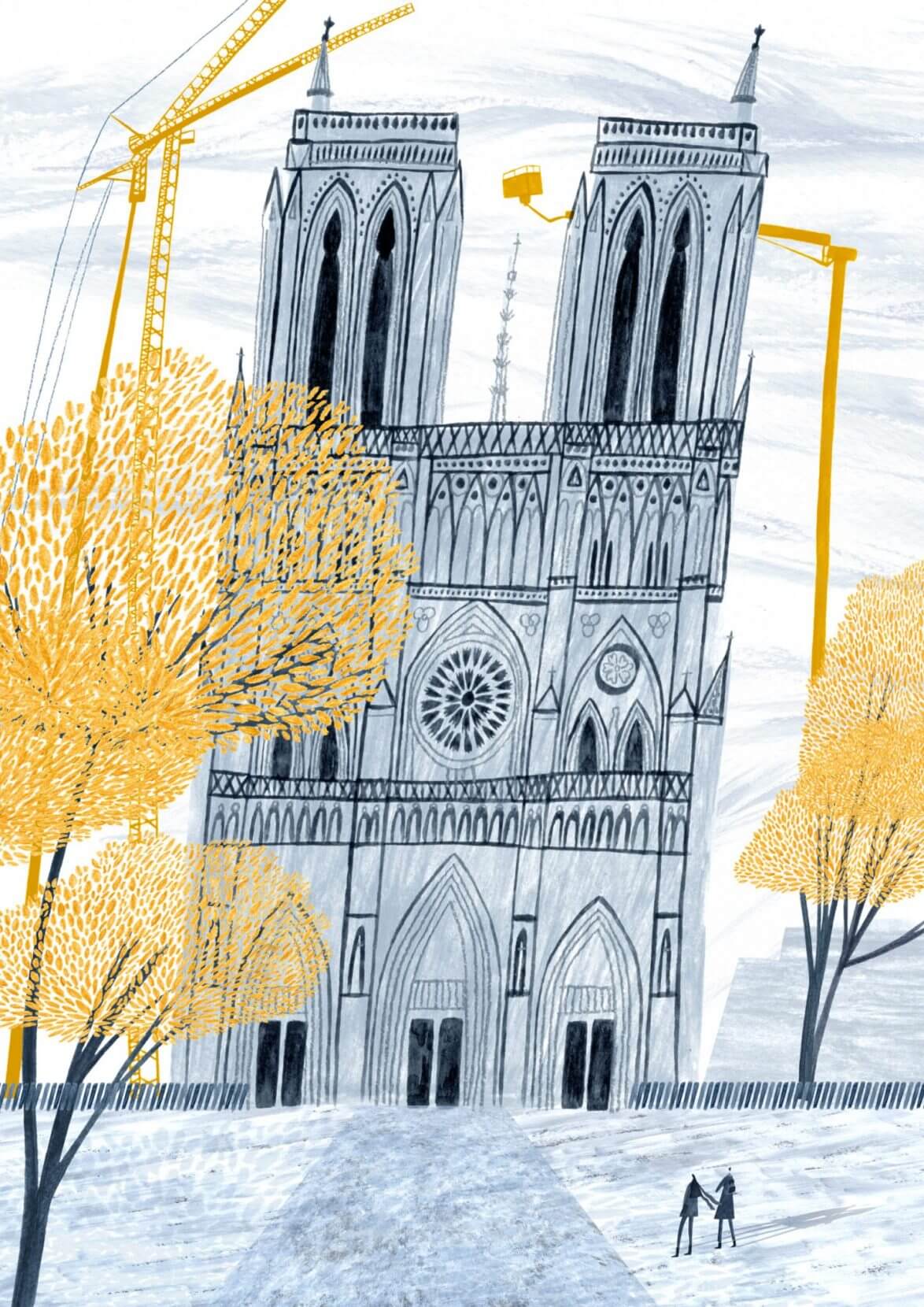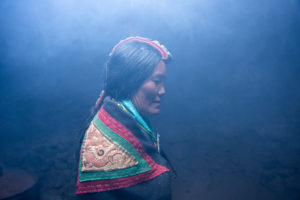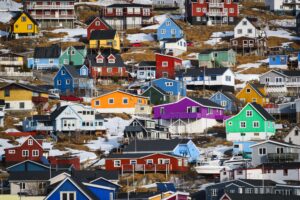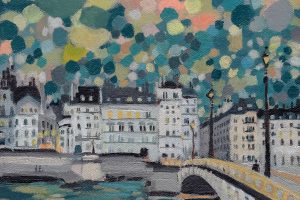Support Hidden Compass
We stand for journalism, science, history, and hope. Make a contribution to Hidden Compass and stand with us.
Little by little, his spirit expanded in harmony with the cathedral.
– Victor Hugo, The Hunchback of Notre Dame
She had lived many lives and here was the burnt offering of another.
Notre Dame’s lace spire sizzled, crumbled, and fell, and the gigantic hole it created became a cauldron. Flames, golden to orange to red, assaulted Paris’ lavender-tinged sky, and smoke billowed in gray explosions. Silhouetted against glowing cinders, her bell towers stood dignified but unprotected.
My friends and I stood on the edge of Île Saint Louis and watched, mouths agape, tears stinging our eyes, joining in a collective, horror-filled gasp as the cathedral battled for her very existence. The hollow, meandering roar of the conflagration was punctuated by the thunder of falling wood and stone, and the screeching of twisting iron and crackling flames.
As I suffered from my fourth concussion, the glow of Notre Dame’s fire was extra-rosy, the cries of onlookers too loud as the crowd edged ever closer…
Victor Hugo’s “vast symphony of stone” had Stravinskied.
Firefighters wrestled with the blaze as the stone edifice trapped heat and smoke, rendering the higher flames in the “forest” of 850-year-old ceiling beams unreachable. They had caught fire like kindling, and the blaze was out of control by the time the firefighters had arrived. Scorched by fierce heat, they ran in to rescue precious relics from the inferno.
As she burned, my gut echoed the sentiment. That night, as I suffered from my fourth concussion, the glow of Notre Dame’s fire was extra-rosy, the cries of onlookers too loud as the crowd edged ever closer to my claustrophobic brain.
~~
Over the past few years, it seemed my own life had caught fire.
I’d gone through a divorce after a 32-year marriage, and ushered my two sons into the world of adulthood in a period of letting go. As I placed precious items from my old life in the California home where I was starting over, I pined for our old house in Washington state.
I’d broken my shoulder, endured four concussions, suffered a stroke, and had a heart recorder inserted surgically.
My father, who had infused my existence with humor and love, had died, and his death hurt in a place that seemed unreachable.
After the stroke, I failed to accept the fact that my life expectancy had lowered, that at times my brain was toast. Daily tasks like pressing garlic or doing dishes caused my head to explode into migraines. I forgot appointments, struggled to find words, and mixed up numbers. My energy plummeted. Depression and anxiety crumbled my equilibrium.
It would take time, the doctors said, to recover.
~~

Illustration by Rosanna Tasker.
Through her years, Notre Dame has offered sanctuary and repose as millions filed into her magnificent interior to meander, listen to music that soared to the heavens, and light candles.
The faithful in Notre Dame, when they pause to ignite a votive, are in the company of much of humanity. Pagan Romans lit wicks near images of their emperors. In Jewish culture, a perpetual light is kept burning in temples and synagogues. Muslims light lanterns during Ramadan and on the graves of their loved ones. Hindus ignite diyas, and Tibetan Buddhists yak-butter-lamps.
But those who light the candles of Notre Dame are not the ones providing the light. Our Lady has been imbued, whether by legend or literature, with human qualities, and it is she who illuminates.
~~
The day after the fire, President Emmanuel Macron addressed the people of Paris: “Notre Dame is our history, it’s our literature, it’s our imagery. It’s the place we live our greatest moments, from wars to pandemics to liberations.”
Notre Dame is situated in the precise center of the starting point of all the roads of Paris, and of France. She is beloved.
The cathedral’s lives have been both glorious and tumultuous.
Her first stone was laid in 1163, and the faithful gathered to light candles. Later, she was graced with her bell towers and received, arguably, her best feature — the north and south rose windows — glittering eyes from which her spirit shone forth. She took 200 years to build.
When she was just three centuries old, Catholics slaughtered Protestant Hugenots en masse over a three-day killing spree, then celebrated their victory at her altar. Soon afterwards, Hugenots attacked her façade, hacking the heads off of her statues — a fad that would continue for centuries.
When she was four centuries old, Louis XIV, realizing that Gothic was out and Baroque was in, had Our Lady’s eyes ripped out and replaced with white glass. Later, Hugo would rant: Who has installed cold white glass in the place of those stained glass windows that caused the astonished eyes of our ancestors to pause between the rose window of the main entrance and the pointed arches of the apse?
When she was five centuries old, fanatics came after her again: Revolutionaries hacked off more statues’ heads, attacked the arrow atop her spire, melted down her bells to make cannons, and renamed her The Temple of Reason.
Through all of this, people continued to light candles under her bright or colorless glass, in turmoil or in peacetime, in sorrow or in joy.
~~
The week following the fire I was a guest writer at a literary event, and had chosen to read from an essay I wrote on Notre Dame. I had analyzed her extensively, inside and out, going deep and using my intellect with zest, for my brain was my center, and I’d written the best essay it could conjure.
But that night, my thinking was dulled. My chest burned and chills wracked my body. By the time I took the stage in an underground cavern packed with poets, artists, and musicians, my throat raged and my voice faltered.
“Her scars and sweetnesses were mine,” I read, wondering if my connection to this cathedral was a blessing or a curse.
~~
Within weeks of the fire, the cause of the blaze was narrowed to two hypotheses: a cigarette tossed by a construction worker, or a short in the electrical system of the bells. Iron scaffolding on the exterior of the spire welded together that night, enhancing the risk of collapse. Hundreds of tons of lead in the spire and roof were released into the night sky, putting surrounding neighborhoods at risk.
The bell towers had been 15 minutes from crumbling due to the heat, but the firefighters had arced water over the blaze to dampen them. The water saved her towers, but seeped into the mortar between her stones. Moving just one — even to rescue her from ruin — could cause collapse.
Nothing could be moved, because all had not yet settled.
~~
Celtic poet John O’Donohue had this to say about the in-between:
You are in the time of the interim
Where everything seems withheld.
The path you took to get here has washed out;
The way forward is still concealed from you.
The old is not old enough to have died away;
The new is still too young to be born.
….
What is being transfigured here in your mind,
And it is difficult and slow to become new.
The more faithfully you can endure here,
The more refined your heart will become
For your arrival in the new dawn.
~~
Moving just one [stone] — even to rescue her from ruin — could cause collapse. Nothing could be moved, because all had not yet settled.
Even so much as a sip of wine caused vertigo, events siphoned my energy at an alarming rate, and I had to concentrate to maneuver around the familiar streets of Paris as if I’d lost my compass arrow. Writing took twice as long; I could work on scenes but had trouble integrating them into a book.
I began to doubt the wisdom of coming to Paris. Notre Dame was a ruin, I had bronchitis, and the gilet jaunes (Yellow Vests) angrily prowled the streets on Saturdays en masse, the cost of renovating this cathedral making it a new target for protest.
~~
In 1830, when Victor Hugo took up his pen with flourish to write the Hunchback of Notre Dame, he created a character who was so intertwined with the cathedral that …
He was its soul. To such a point was he, that those who knew that Quasimodo once existed, now find that the cathedral seems deserted, inanimate, dead. You feel that there is something missing. This immense body is empty; it is a skeleton. The spirit has departed; you see the place it left, and that is all. It is like a skull: the sockets of the eyes are still there, but the gaze has disappeared.
At the time, Notre Dame was a spectral wreck, matching Hugo’s image. The people rallied and the city renovated, but Quasimodo had to wait 25 years for his new home to be completed.
~~
Nearly 100 years after Hugo published his novel, bombs, bullets and shrapnel punctured Notre Dame’s stone as World War I shook Europe. The cathedral was built to last, but by this time she may have felt disaster-prone.
During World War II, her eyes were removed again and she endured four long years of blind silence, her bells mute. By the liberation of Paris on August 25th, 1944, Our Lady’s demise was imminent. But when Hitler ordered his general in Paris to detonate her, Dietrich von Choltitz surrendered the city instead.
The very next day, Charles de Gaulle, who had led Free France and the Free French Forces against Nazi Germany, approached Notre Dame. Parisians had fought the Germans from barricades — piles of tables and chairs and stools, with any weapon they could find — and chaos still reigned. German snipers remained high in the Gothic arches.
BBC correspondent Bob Reid’s radio broadcast described the scene:
And now, here comes General de Gaulle.
The general’s now turned to face the square and this huge crowd of Parisians [machine gun fire]. He’s being presented to people [machine gun fire]. He’s being received [shouts of crowd, shots] … even while the general is marching [sudden sharp outburst of continued fire] … into the cathedral.
De Gaulle walked straight ahead — shoulders high, his tall frame never flinching as bullets zinged from all sides and people scampered for shelter — into Notre Dame’s interior to a blizzard of fire from the rafters. He remained for a 15-minute celebration.
Our Lady of Paris had been waiting a long time for this, and her bells rang out.
~~
Louis XIV, that long-haired hippie of a monarch (was not Versailles a manicured version of Burning Man?), so hated to suffer waiting, that after one courtier appeared late, he was said to have drawled, “J’ai failli attendre” — I almost had to wait! He considered it his divine right never to suffer a delay, but Parisians have learned — through revolutions, wars, reigns, and riots, in queues and métro stations, in bistros and museums — that most of us have to wait.
In the days following the fire, I dragged myself out to observe the people of Paris and scrutinize the incinerated cathedral from all sides. Access to Notre Dame was blocked, so crowds flocked to Île Saint Louis to ponder her cinders and ash, the gaping hole in the center of her flying buttresses, her singed but intact rose windows, like eyes with smudged mascara. I heard other languages, but the French voices were silent. The people of Paris — an elegant Parisienne in white, a swarthy father holding the hands of twin boys, two elderly men dressed with old-fashioned tidiness — quietly contemplated Notre Dame.
I had seen this kind of homage a few years before, when the bells of Notre Dame were replaced. That winter, the new bells were displayed in the cathedral’s nave. Bleachers were set out and people sat on freezing metal seats to meditate on the bell towers. Tourists fidgeted, but Parisians sat still as statues. Three old ladies in black wool coats and colorful scarves and hats, their lipstick fresh, sat just so; a young couple snuggled side by side with intertwined legs. All listened to the chiming of the old bells, and imagined the sound of the new. Would they be sharper or gentler, hollow or full?

Illustration by Rosanna Tasker.
Attendre is French for “to wait.” It also means “to expect.” A queue ahead of the entrance to a Dalí exhibit at the Pompidou gives us a chance to consider the mustachioed genius who wielded his paintbrush with panache. Clustering in the foyer of a bistro allows us to be overtaken by celestial scents and anticipation to stir the blood.
Perhaps the French take the long view; the past is prologue. To honor the old and envision the new are one and the same. To wait is to expect.
As for me, it was not so easy to emulate the French.
~~
All summer her sanctuary was open to the elements. Her interior remained a jumble of accumulated debris. Charred wood like pick-up-sticks and stone chunks lay on the floor in pinpoint rays of sunlight, on shredded cane chairs, among piles of ashes. Everything could cave in at any moment. Even months after the fire, Notre Dame was still considered a triage site.
Meanwhile, my own condition worsened. Neurological testing revealed a chasm in memory, in word retrieval, in vision. The latest concussion had sparked the cumulative effects of all four concussions and the stroke, and my brain remained in chaotic clutter along with the issues I’d traveled to Paris to escape.
Even with my divorce finalized, I did not see a way forward. I had assumed, falsely, that I was emotionally prepared, but was consumed by grief. I had not calculated this. I raged at the ravages of age on my appearance — the last time I dated I was in my twenties, but I had no desire to be a nun.
During the suspended summer-into-fall, I often woke up alone with an iron band of fear sinking into my chest: My brain was not strong enough to be my center, and this left a terrifying void.
But in those instants, I tried to take a longer view. I came to see that Hugo’s belief in Quasimodo swinging from those flammable rafters, Charles de Gaulle’s heroic stride, and the resilience that Our Lady herself displayed in all her brokenness were not qualities of the brain. They were qualities of the heart.
~~
Recently, my family scattered my dad’s ashes into Puget Sound, Washington. He’d been gone three years — we agreed that we were glad we waited. As his ashes floated and swirled, then sank into the murkiness, chips and clumps mingling with the water, we spoke of his humor, the music he played on the piano and drums, and his fiercely loyal love — all that remains of him, now that the ashes are gone.
~~
Now it is winter. I am free of many concussion symptoms. My vision is clear, I can drive, and the scenes I wrote in longhand are fitting into my novel nicely.
Now is the time when everything seems withheld. We’ve been here before and we will be again.
I look around my home at what remains of my previous life: The Greek vase and Swedish plate on my mantle, crystal candle holders, photos of the four of us as a family in the old way and the new, my dad’s bongo drums. Like Quasimodo, I have had to wait, but my home has become the place where I live my greatest moments, my wars, my pandemics, my liberations.
Our Lady, however, remains in the interim. Her roof was carefully covered in the fall, but she remains bound inside her melted iron scaffolding. Christmas came and went with no mass, no movement, no restoration in her sanctuary. Now is the time when everything seems withheld. We’ve been here before and we will be again.
But inside the cathedral, among the detritus and dust, stands the altar with its gold cross, and next to that, the marble pietà where Notre Dame’s namesake cradles Jesus in her lap. The center of the center remains, and the rest will be re-imagined.
~~
Each night, I light three candles in a row. I contemplate them in the way I learned from the people of Paris, who find layers of meaning in the combination of past, present, and future. Sometimes the past fizzles out (gratefully), or it’s time for a new present (a fresh start), or the future grows dim (but still illuminated).
A few nights ago, the past and the future went out at exactly the same moment. So tonight, fresh candles burn on either side of the present, creating a silhouette of Notre Dame as she now stands — her tall spire gone, and her low center flanked by her bell towers. I remember that cauldron of violent flames licking the sky.
Parisien magazine wrote, “La catastrophe nous renvoie à nous humilité et notre impuissance” — the catastrophe refers to our humility and our helplessness. It is during these times of catastrophe when I am aware of both; and that what endures becomes clear. Notre Dame is about to start another life, and hundreds of ideas are flooding in for a new spire, a new future, a sublime reincarnation.
But until Our Ravaged Lady can rise from the ashes, we have to do as she does: feel our universal humanity, and stand with dignity in humility and helplessness. To light a few candles … and wait.
###
Working from her Bristol studio, Rosanna Tasker creates elegant illustrations full of elongated forms, natural settings, fascinating characters and subtle color schemes. See how her work comes alive at http://www.rosannatasker.com/.
An expanded version of “Our Ravaged Lady” was awarded Grand Prize Gold in this year’s Solas Awards for best travel writing. The awards are given out each year by Travelers’ Tales publishing.
Erin Byrne
Erin Byrne's books, travel essays, poetry, fiction, films, workshops, and events capture the mystical transformations unleashed by travel and connections across the globe.
Never miss a story
Subscribe for new issue alerts.
By submitting this form, you consent to receive updates from Hidden Compass regarding new issues and other ongoing promotions such as workshop opportunities. Please refer to our Privacy Policy for more information.



